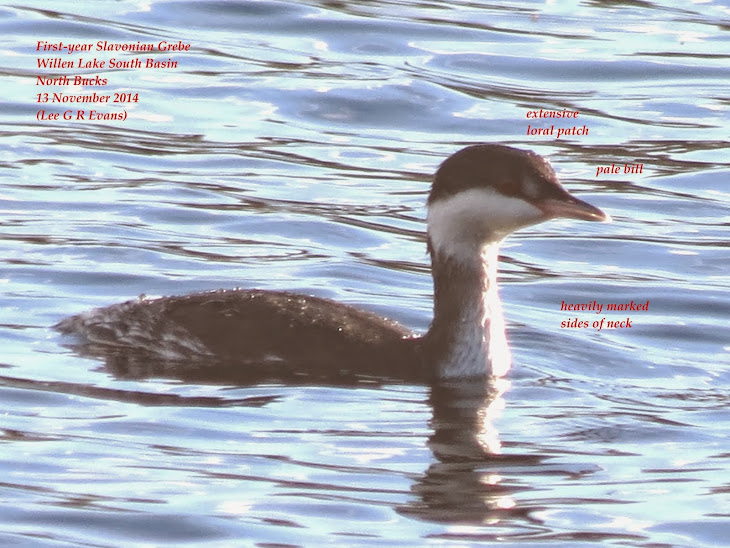


HAWFINCH (DAVE HUTTON) - Not taken in Buckinghamshire unfortunately but of a particularly confiding bird this winter at Cannock Chase in Staffordshire.........
THURSDAY 15 JANUARY 2009
A much colder day again, with the wind veering due west. Although dry, remained grey and overcast throughout.
Road casualties were the order of the day with a dead Badger in Chorleywood (at the side of the A404 at TQ 032 967) with another on the A41 near Hemel Hempstead, and an adult Black-headed Gull and first-winter Mute Swan both hit and killed by drivers as I drove towards Aylesbury.
WENDOVER BYPASS
A flock of 60 Fieldfare were feeding on Hawthorns just west of the railway cutting.
UPPER WENDOVERDEAN FARM SLURRY FIELD (SP 875 047)
I visited my favourite field again today and it was bursting with birds: 660 corvids including 202 Rooks and 458 Jackdaws, 313 Woodpigeons, 35 Feral Pigeons (including 13 Fan-tailed Doves), 281 Common Starlings and 76 Chaffinches. Most impressive was a single flock of 147 EURASIAN SKYLARKS - my largest flock this winter.
At least 3 RED KITES were hanging around, as well as a single Common Buzzard.
It was here that I heard from Paul Moon that Rob Hill had discovered TWO HAWFINCH, literally half a mile from where Rob Norris had found one just a couple of days ago (and where I had spent 90 minutes searching in vain the same day). I quickly contacted Rob H and discussed with him my options. It was worth a go I thought, particularly as Rob had left them there still showing.
GAYHURST HOUSE (SP 847 462)
I arrived on site at 1425 hours and immediately began searching the small isolated scrubby patch east of the barn, just 90 yards beyond the road stile. Viewing from the car, the Hawthorns were birdless apart from 18 Blue Tits moving through after spending the day feeding in the nearby village. I waited awhile but there was still nothing. I was soon joined by local birder Graham Squirrell and whilst chatting to him, I heard the HAWFINCHES and the sound was coming from the tall trees surrounding the pond in the private Gayhurst Estate. Within seconds of me getting on to them, the birds took flight - and there were THREE BIRDS. They took to the air and flew overhead, two birds quickly returning and the other flying off SE towards Mill Farm. The two then returned to the Evergreen Fir trees (where they perhaps roost) and quickly disappeared into the foliage. There is also a row of old Hornbeam trees in the estate - again, a favoured feeding tree. Ideal habitat and indicating that they have probably been around for some time. The birds were extremely vocal, with their loud 'ticking' call being clearly heard.
Some excellent refinding by Rob H - first rate and bang on target - with Hawfinch pushing me through the 100 barrier for the year (Buckinghamshire).
The location is more than a little bit precarious with warning signs up all around. Gayhurst House and village are strictly private and one can only view from the lane that leads up to Dairy Farm. Whilst I was there, 7 vehicles came and went, all enquiring as to why I was there (and reiterating that it is private). Hopefully, the birds will favour the bush clump adjacent to the barn, where they can be seen easily from the car. In fact, there is a small pond therein and maybe that is why the Hawfinches and other birds visit this isolated clump.
Access is off of the Haversham road at SP 850 457. After 800 yards you cross a stile and before you arrive at the barn on the left, the bushes are obvious to the left. The Hornbeams, Firs and gardens are immediately on your right.
The Dairy Farm fields held 23 Linnets.
LINFORD NR
Four LITTLE EGRETS were pre-roosting on the main lake, with Grey Herons prospecting the nests on the island. There were few wildfowl other than 35 Teal, 8 Pochard, just 15 Eurasian Wigeon and a drake Common Goldeneye, whilst 112 Lapwings and 3 Common Snipe were roosting on the bund.
Most interesting was a large white-headed gull standing with two adult Common Gulls. Clearly bigger and with a similarly shaded grey mantle, it had sepia-grey coloured legs, rather long and lanky. It had a completely white head but a rather rounded head and did not have an aggressive feel nor a long sloping forehead. It had a small, dark, beady eye and a relatively thick pale green bill with an orange-red gonydeal spot. It was long-primaried but rather small in size. I did not get a good look at p10. It was very close to near adult in plumage but with some immaturity in the outer primaries and primary coverts. Although I suspect it has Caspian Gull influence, it just did not seem absolutely right for that species.
Just around the corner, by the old ruins, Graham was watching a BARN OWL (my first of the year) and within five minutes, a Common Buzzard appeared and in no time physically attacked the Barn Owl, forcing it to dash for shelter in the wood behind. This is the first time I have seen actual physical contact between these two species but confirms Dave Anderson's studies in that Common Buzzard is their main predator.
A single SHORT-EARED OWL was showing well (before dogwalkers arrived) and a pair of BULLFINCH were noteworthy.
WILLEN LAKE NORTH BASIN
A COMMON REDSHANK was showing well in front of the hide, feeding with 33 Lapwings.
At the reedbed end, I was surprised to find a skulking Mr Hill, no Bitterns but two noisy WATER RAILS and 1-2 'exploding' CETTI'S WARBLERS.

